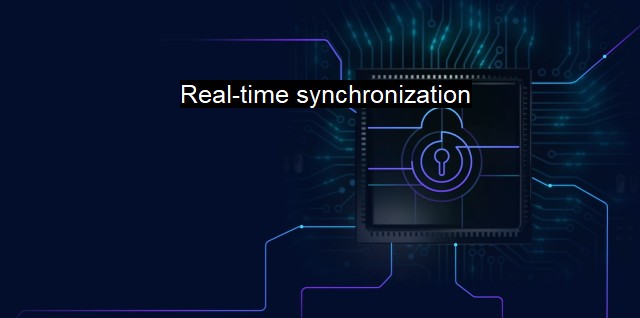What is Real-time synchronization?
Real-Time Synchronization: A Critical Concept in Cybersecurity and Antivirus Technologies
Real-time synchronization is an advanced technology primarily used in the field of cybersecurity and data management. It ensures that multiple systems or databases maintain the same up-to-date information concurrently. Synchronization is a process in which changes in one location are immediately updated in other locations as well. It closely aligns to the adage, "time is of the essence," where in a context like cybersecurity and antivirus, a delay of even a few seconds can potentially lead to a catastrophic loss or breach of data.Real-time synchronization works on the principle of interlocking updating mechanisms within one or more related systems. For instance, if a file is edited on a locally hosted computer, real-time synchronization ensures that this change is instantly reflected on the backup cloud server and also on other devices connected to the same network. The same mechanism applies to addition and deletion of data as well. Consequently, it fosters optimal data coherency and integrity across various platforms.
The real-time synchronization technology augments the function of antivirus applications. The evolving mode of operation of modern cyber threats, which includes data breach, virus infestation, ransomware attack, etc., intensifies the need to have an up-to-the-minute protective mechanism that can retort effectively to threats and neutralize them.
An antivirus with real-time synchronization capabilities scans the user's device or system incessantly. It doesn't merely inspect for pre-existing threats; instead, it initiates its protective shield every time the user accesses new information from diverse sources, opens an email, launches an application, or conducts an online transaction.
Regardless of the action undertaken by the user, the important constraint here is 'time.' The moment the data lands on the user's system, the antivirus's real-time synchronization capability instantly gleans through the information, diagnosing it from potential threats. This real-time process helps save the malicious worms from making a nest in the user's system, thereby preventing gradually unfolding damage.
Besides data integrity and cybersecurity, real-time synchronization significantly contributes to the comfort, versatility, and momentum users want in today's interconnected world. It harbor seamless accessibility across platforms and devices, where users can pick up from where they left off, irrespective of which device or operating system they use.
Nonetheless, it is important to remember that as beneficial as real-time synchronization is, implementing it without a top-notch security system can lead to extensive damage. Since accessibility is prevalent, cyber threats that manage to penetrate one system could feasibly affect all others that are synced in real-time. This puts a higher risk for sensitive information to be disseminated more broadly and create a magnified set of potential vulnerabilities and risks.
It means that while real-time synchronization is a bonus for antivirus and cybersecurity, they should be seen as a pair, not standalone solutions. To leverage real-time synchronization effectively, robust cybersecurity measures should concurrently be implemented. Regular system scans, routine software updates, fed-on-time threat diagnostics, and encryption of sensitive data are some measures that require equal attention and execution. User diligence, in terms of maintaining strong, unique passwords and adopting healthy browser habits, also adds to this layer of protective shield.
To summarize, real-time synchronization shows excellent potential in strengthening cybersecurity and antivirus both at the micro and macro level. It maintains system continuity while offering unparalleled security assurance. It is, thus, indispensable to contemporary data and security networks. this advance technology also comes with its inherent warnings that mandate the use of high-grade and comprehensive protective measures to suppress the cascading cybersecurity risks that modern digital world so predominantly presents.

Real-time synchronization FAQs
What is real-time synchronization in cybersecurity?
Real-time synchronization in cybersecurity refers to the process of updating data, files, or information across multiple devices or systems simultaneously and automatically. This ensures that all systems have the same data and are protected against cyber threats in real-time.Why is real-time synchronization important for antivirus software?
Real-time synchronization is important for antivirus software because it allows the software to constantly update and protect against the latest threats. Without real-time synchronization, antivirus software may miss new threats and leave systems vulnerable to attacks.How does real-time synchronization work in antivirus software?
Real-time synchronization in antivirus software works by constantly checking for updates to virus definitions and threat intelligence. When a new threat is detected, the antivirus software immediately updates and applies protection, ensuring all devices and systems are safeguarded against the latest threats in real-time.Can real-time synchronization help prevent cyber attacks?
Yes, real-time synchronization can help prevent cyber attacks by ensuring that all devices and systems are protected against the latest threats in real-time. This minimizes the window of opportunity for cyber criminals to exploit vulnerabilities and launch attacks on unprotected systems.| | A | | | B | | | C | | | D | | | E | | | F | | | G | | | H | | | I | | | J | | | K | | | L | | | M | |
| | N | | | O | | | P | | | Q | | | R | | | S | | | T | | | U | | | V | | | W | | | X | | | Y | | | Z | |
| | 1 | | | 2 | | | 3 | | | 4 | | | 7 | | | 8 | | |||||||